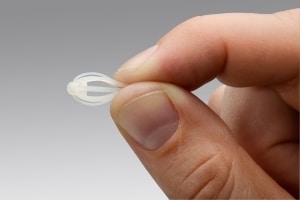Nasal polyps are benign growths that occur on the mucosal lining of the nasal passages. They are typically small and though noncancerous can still cause obstructions of the sinuses, leading to congestion, breathing problems and sinus infections.
Signs & Symptoms of Nasal Polyps
Some nasal polyps are tiny and cause few problems. Others produce symptoms such as runny nose, congestion, sneezing, loss of smell and taste, postnasal drip, headache, sinus pain and pressure and snoring. If symptoms persist longer than ten days and are not associated with a cold or allergies, seek medical attention. Even though nasal polyps are benign, if left untreated they can grow large enough to cause serious complications including obstructive sleep apnea, meningitis, blood clots and aneurysms.
Causes of Nasal Polyps
Some people develop nasal polyps randomly, but most often there is some sort of triggering mechanism. Common triggers include asthma, hay fever, chronic sinus infections, cystic fibrosis and sensitivity to aspirin and other NSAIDs. Genetics may also play a role.
A diagnosis is usually made through visual inspection with an otoscope or nasal endoscopy. An imaging test, either a CT scan or MRI, can be useful in determining the size of the polyp and in ruling out more serious growths, such as tumors. Allergy tests may be administered in order to identify the substance responsible for your symptoms.
Treatment for Nasal Polyps
Nasal polyps can be treated with either medication or surgery. The goal is to reduce the size of the polyp or remove it completely in order to alleviate your symptoms. Nasal sprays, oral or injectable steroids, antihistamines and antibiotics are all common drug treatments. If they are ineffective, surgery may be performed. The type of procedure depends on the size of the polyp.
An outpatient procedure called a polypectomy uses a suction device or microdebrider to remove the lesion and surrounding tissue, and is effective for treating smaller polyps. Larger ones may require endoscopic sinus surgery. In this procedure, a camera is mounted on a flexible tube, and tools on the end are used for excising the polyp.
Sinuva

Sound Health Services is among the first in the United States to offer a non-surgical procedure for patients who suffer from repeat nasal polyps with SINUVA™ (mometasone furoate) Sinus Implant. SINUVA is proven to reduce polyps and nasal congestion and obstruction.1
WHAT IS SINUVA
SINUVA is a sinus implant that treats nasal polyps without surgery. During a routine office visit, a Sound Health physician will use topical and/or local anesthesia to numb the patient’s nose and sinuses. SINUVA is then placed in the sinus cavity through the nasal opening.
HOW SINUVA WORKS
Its innovative design provides a 2-in-1 approach: it is designed to open in the sinus cavity and release anti-inflammatory medicine to treat nasal polyps for up to 90 days.
PATIENT EXPERIENCE WITH SINUVA
SINUVA BENEFITS (AT DAY 90)2
- Significantly reduces nasal obstruction and congestion
- Significantly improves impaired sense of smell
The most common adverse reactions observed in a clinical trial were bronchitis, upper respiratory or middle ear infection, headache, light-headedness, asthma and nose bleed. SINUVA is indicated for adults with nasal polyps who have had ethmoid sinus surgery.
For more information about SINUVA, visit www.SINUVA.com. For education and resources on chronic sinusitis and chronic sinusitis treatment options, visit www.MySinusitis.com.
Call Sound Health Services for more information or to schedule an appointment.
1SINUVA Prescribing Information, Intersect ENT. December 2017.
2Data on file, Intersect ENT. RESOLVE II Rev. 3.0 CSR R 28017; February 2017.
INDICATION
SINUVA™ Sinus Implant is a drug-releasing (mometasone furoate) implant indicated for the treatment of nasal polyps, in patients ≥ 18 years of age who have had ethmoid sinus surgery.
IMPORTANT SAFETY INFORMATION
If you have a known hypersensitivity to the mometasone furoate drug or any of the ingredients in SINUVA, do not use SINUVA. Hypersensitivity reactions, including rash, itch, and swelling have been reported with use of steroids. If steroid effects such as Cushing Syndrome and adrenal suppression appear, consult your healthcare professional.
SINUVA is made from bioabsorbable polymers designed to soften over time. As the implant softens and polyps decrease, the implant may be expelled out of the nose on its own or with actions such as sneezing or forceful nose blowing. The implant can be removed 90 days after placement or earlier at the physician’s discretion. Repeat administration of SINUVA has not been studied.
As with other endoscopic sinus procedures, there are risks associated with the insertion or removal of SINUVA. SINUVA should be inserted by physicians trained in otolaryngology. Discuss risks related to insertion or removal of SINUVA with your healthcare professional. Your healthcare professional will monitor the nasal tissue adjacent to the SINUVA Sinus Implant for any signs of bleeding, irritation, infection, or perforation. SINUVA should not be used in patients with nasal ulcers or trauma. The most common adverse reactions observed in clinical studies were bronchitis, upper respiratory or middle ear infection, headache, lightheadedness, asthma, and nose bleed.
If you experience excessive nasal bleeding, symptoms of infection or symptoms suggesting that the implant has moved, such as irritation or a choking sensation in the back of the throat, immediately contact a healthcare professional. Close monitoring is recommended if you have a change of vision or a history of increased intraocular pressure, glaucoma and/or cataracts.
You may report side effects to your physician or to the FDA at (800) FDA-1088 or www.fda.gov/medwatch. You may also report side effects to Intersect ENT at (866) 531-6004. RX Only. For important risk and use information about SINUVA, please see Full Prescribing Information or visit www.SINUVA.com.